Sikkanadar, (also called Kuduminadar), facing east
Sikkanadar Kudumiyanmalai
Sikkanadar, Kudumiyanmalai
Saivite Temples, Pudhukottai District
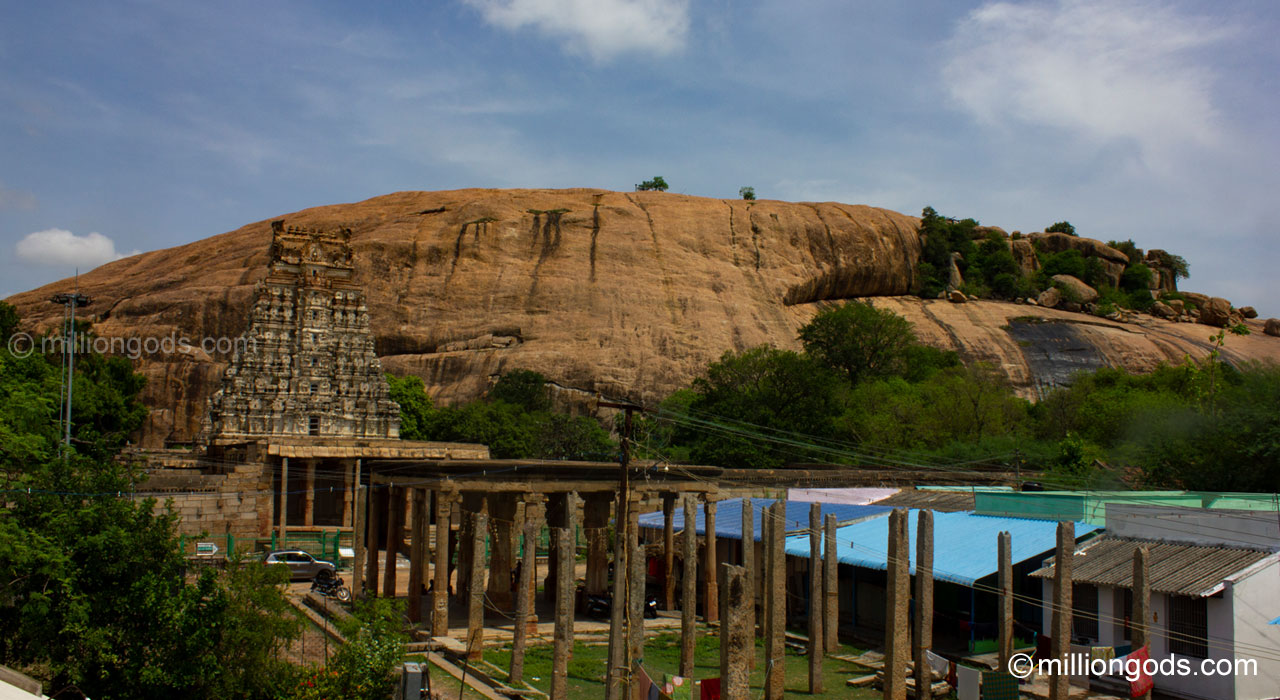
God
Goddess
Akhilandeswari, facing east
Other Deities
Nandi, Shiva & Parvati, Dwarapalakas, Vinayaka, Saptha Maadhar, Idampuri Vinayaka, Valampuri Vinayaka, Panchabootha Lingams, Sahasralingam, Murugan with cosorts, Gajalakshmi, Aadhi Shivan, Parvati, Chandran, Surya, Bhairava, Navagraha
Sanctum Niches – Dakshinamurthy, Lingotbavar, Brahma, Durga, Chandikeswara
Sikkanadar Kudumiyanmalai is a large and ancient temple where the main deity has a tuft (Kudumi) on top of the head which has given the name of the lord as Kuduminadar. Outside in the main street is a large Nandi in a Mandapam. The houses are on either side as you walk down to the temple. A Mandapam is in front is preceded and followed by tall pillars that have acted as supports for canopies in those days itself. This is followed by an entrance mandapam with beautiful carved tall pillars on either side. These pillars are sculpted with wonderful Dasavatara and Anjaneya idols. Of particular mention are the two sculptures of the Kalki Avatar of Lord Vishnu where he is depicted in his youth and old form riding the horse. On either side of this entrance mandapam extend the 1000 Pillared mandapam, though it practically has 645 pillars. The 7 tiered Rajagopuram leads inside. On either side of the entrance are two large Dwarapalaka idols with eight hands and is followed by another long entrance Mandapam. This mandapam has some sculptural wonders including, Ganesha, Ravana, Karthikeya, Agora Veerabadra, Mohini, Kali, Rati, Manmada. Oorthuva Thandava Moorthy and others. The sides of the mandapam leads out into the outer Prakaram where there are more Mandapams. The Prakaram is filled with beautiful Mango and Frangipani trees. The Mandapam on the south west corner has some wonderful Yaali carvings on the Pillars. The walls of the inner Prakaram are about 20 feet tall and are filled with inscriptions from bottom to top all around. Right behind is a small door that leads to the cave temple behind. As you enter this door on the left is the goddess shrine with a mandapam in front leading to the sanctum. In the middle is a tall mandapam under which is a beautifully carved Vinayaka and lots of inscriptions with large letters. The cave temple on the right is on a elevated platform and is reached by climbing a few steps. This original cave temple with its pillars, pilasters, ceiling, deity and the beautiful smiling Dwarapalakas are a single carving out of the face of the mountain. This Lingam has a square base and is very large. On the walls of this sanctum are some musical inscriptions. Beside that is a carving of Vinayaka with his trunk turned to the left. There is a mandapam built separately later where a large Nandi is seen facing the lord. Seen from outside on top of the cave at a height is a east facing carving of lord shiva with his consort seated on the bull mount. On either side of this carving are the carvings of the 63 Nayanmars, also on the east facing hill face. This is a unique feature seen nowhere else. Coming out of this enclosure in the outer Prakaram on the left side of the main sanctum sanctorum is the separate sanctum of the Goddess Akhilandeswari. A long mandapam is in front of the sanctum. In the front portion of this mandapam facing the south is the Palliarai (reclining chambers of the divine couple). The entrance to this chamber has beautiful decorative stucco carvings which had been painted with herbal paints originally. The paint has worn of now and only remnants can be seen here and there. In the front is a Hexagonal Mandapam. Also present is a small mandapam called the Rasi Mandapam, the ceiling of which has carvings of the Zodiac signs. The goddess shrine itself is constructed with shining granites which are said to have been developed later by the Vijayanagar Kings. Coming around the Prakaram on the sides of the entrance to the inner Prakaram are two beautifully carved Dwarapalakas. The main deity is a tall and large Shiva Lingam with a tuft on top of the head.
Holy Water (Theertham) – No information
Sacred Tree (Sthala Vriksham) – No information
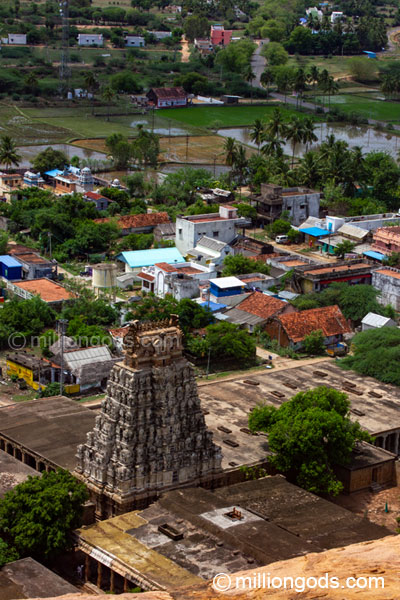
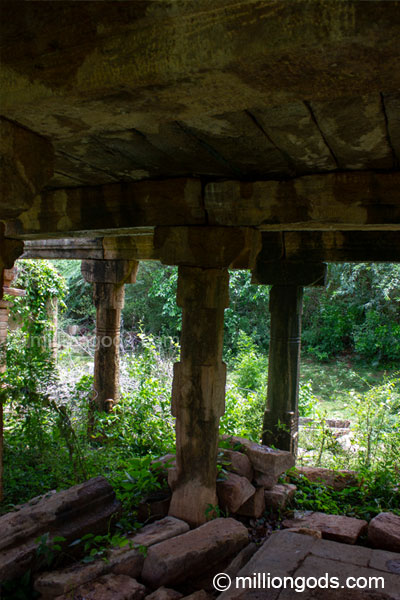
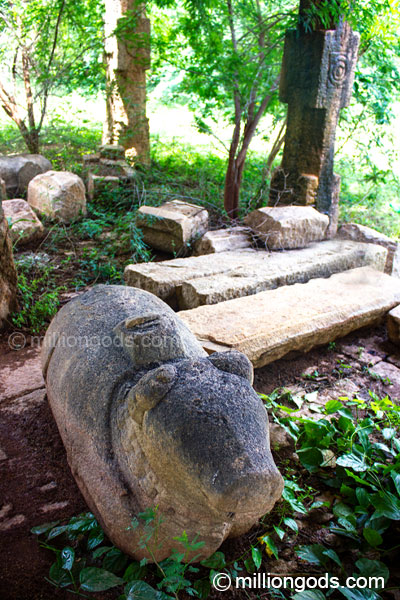
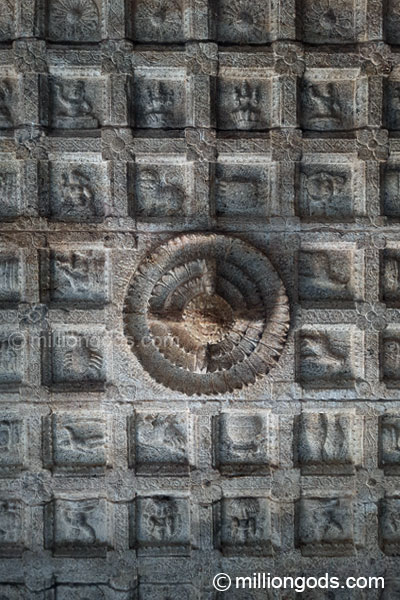
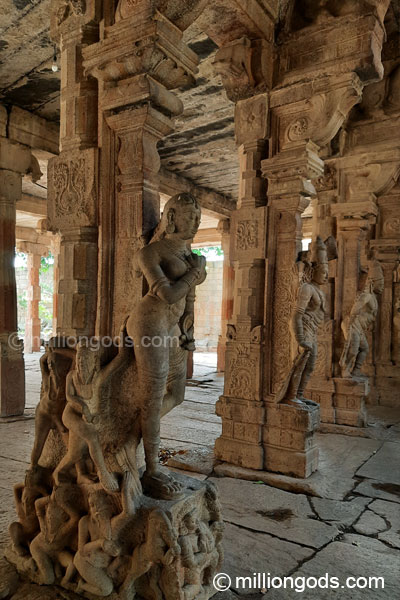
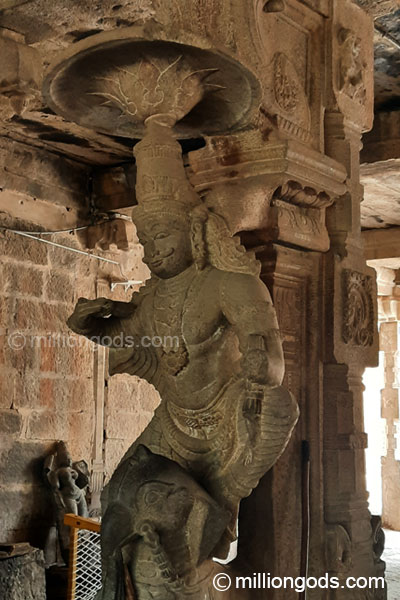
History
There are about 120 inscriptions in the cave and the temple. In them the village is referred as Tirunalakkunaram, “the sacred and prosperous hill”. From the 12th Century CE, the village is referred as Shikhanallur. The present name, Kudumiyanmalai, is first found in a 17th Century CE inscription of Mallappa Pallavarayar.
First to be created was the Cave temple somewhere in the 7th Century CE by the early Pandyas. Earlier it was thought that the cave temple was excavated by the Pallavas through their vassals Muthariyars. Later the Sikkanadar Kudumiyanmalai temple was built up by the Cholas in the 10th Century CE, subsequently expanded by the Pandyas and the Vijayanagara Kings between 13th and 15th Century CE. The sculptures in the Mandapams belong to the Vijayanagar period. The Maha Mandapa in front of the cave temple was built during the reign of Kulothunga Chola I (1070 – 1120 CE). The Mandapa in front of this was built during the reign of Raghunatha Raya Tondaiman (1686 – 1730 CE). Vijaya Raghunatha Raya Tondaiman (1730 – 1769 CE) built the steps leading up. To the south of the cave temple in a tall mandapa is the famous Musical Inscriptions carved in Pallava Grantha script and is thought to be dating back to around 7th Century CE. This script has led to many controversies about who carved them. But we leave that to the experts to sort out and look at the contents.
(Taken from an interview with Prof. T.K. Venkatasubramanian published in https://www.sahapedia.org/kudumiyanmalai-inscriptions)
The inscription is divided into seven sections corresponding to the seven classical ragas of the time. These seven sections are 1) Madhyamagrama, 2) Sadjagramah, 3) Shadava, 4) Sadharita, 5) Panchama, 6) Kaishikimadhyama, and 7)Kaishika. Each section consists of a collection of groups of four notes, arranged in sub-sections of sixteen, each sub-section taking up one line of the inscription. The music in the inscription appears to be intended for the vina, since it has been given the title chatushprahaarasvaragamah or authoritative texts of notes produced by four striking (of the string). It is clear that the seven ragas of the inscription do not appear in the Natyasastra of Bharata, but they appear in Samgita-ratnakar. Hence this inscription is the earliest record of these seven ragas, however when they came into existence is not very clear. Prof.D.R.Bhandarkar who edited this inscription first suggested that this inscription belongs to the seventh century AD. French Archaeologist Gabriel Jouveau-Dubreuil (1885–1945) who specialized in inscriptions of Southern India suggested that Mahendravarman could be the author. T.N. Ramachandran, the then Joint Director-General of Archaeology, also thought it is Mahendravarman and is mentioned in an article titled ‘Mahendravarman, the Royal Artist’(1931). The other possible author of this inscription is Rudracharya who has written a work called Shringara Tilakam. Rudra, Rudraka, Rudrabhatta and Bhattarudra are names mentioned in Jaina and Shaivite literature of seventh-eighth century AD. The Kudumiyanmalai inscription is considered a very important inscription since recitation is actually defined.
Legend
The priest of Sikkanadar Kudumiyanmalai was relaxing in the temple with when the King paid a surprise visit. He hurriedly took a flower from one of the Devadasi’s (women dedicated to the temple) head, placed it on top of the deity’s head and gave to the King as an offering. The king noticed a hair on the flower, was suspicious and locked the priest inside the sanctum. The priest prayed to the lord repenting for his folly and to the surprise of all when on the next day the king came near, the head of deity had a tuft of hair on top. Upon pulling it blood came out. Thus came the name of the deity and hill as Kuduminadar, Sikkanadar and Kudumiyan Malai.
Directions
Sikkanadar Kudumiyanmalai is about 18 kilometers west of Pudukottai on the road going to Kodumbalur. Kodumbalur is near the Thiruchirapalli – Madurai Highway.
Stay and Food
None locally. Closest is Pudukottai and Tiruchirapalli depending on your travel plans.
